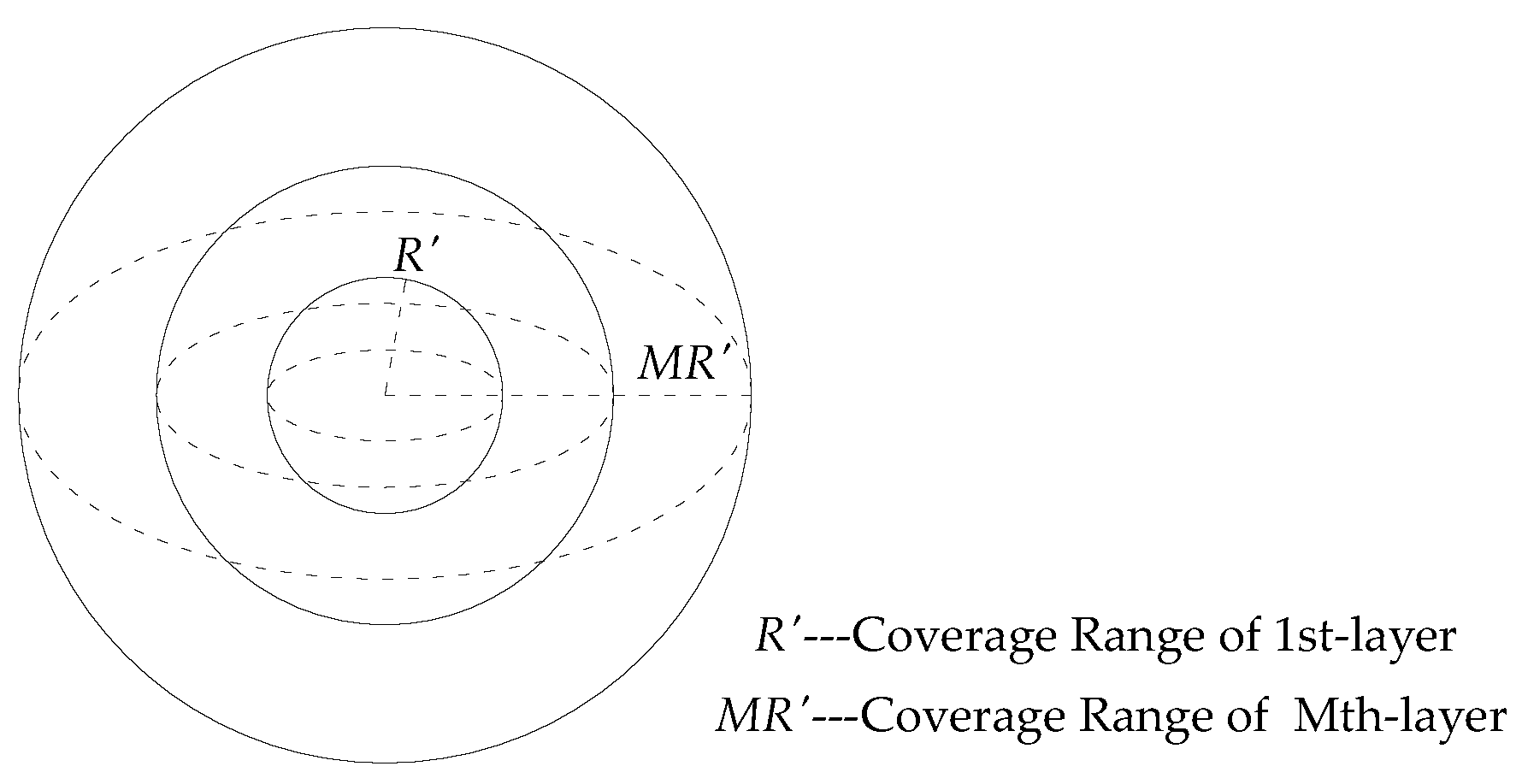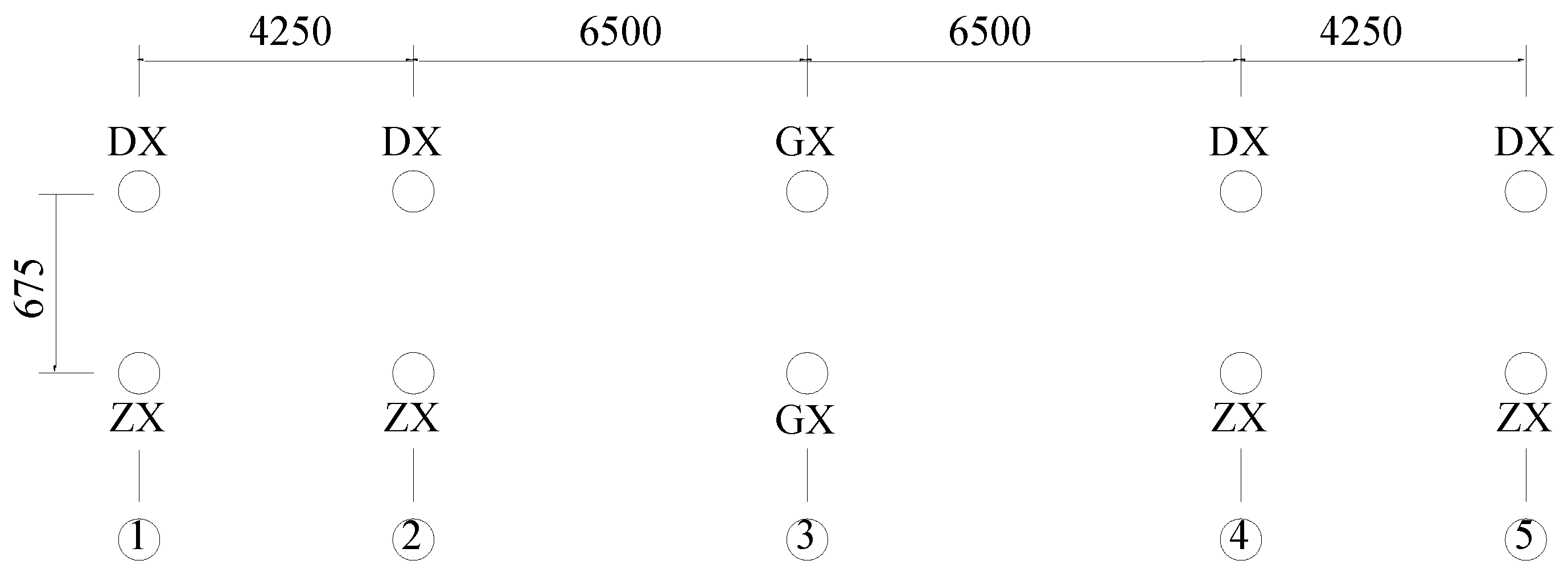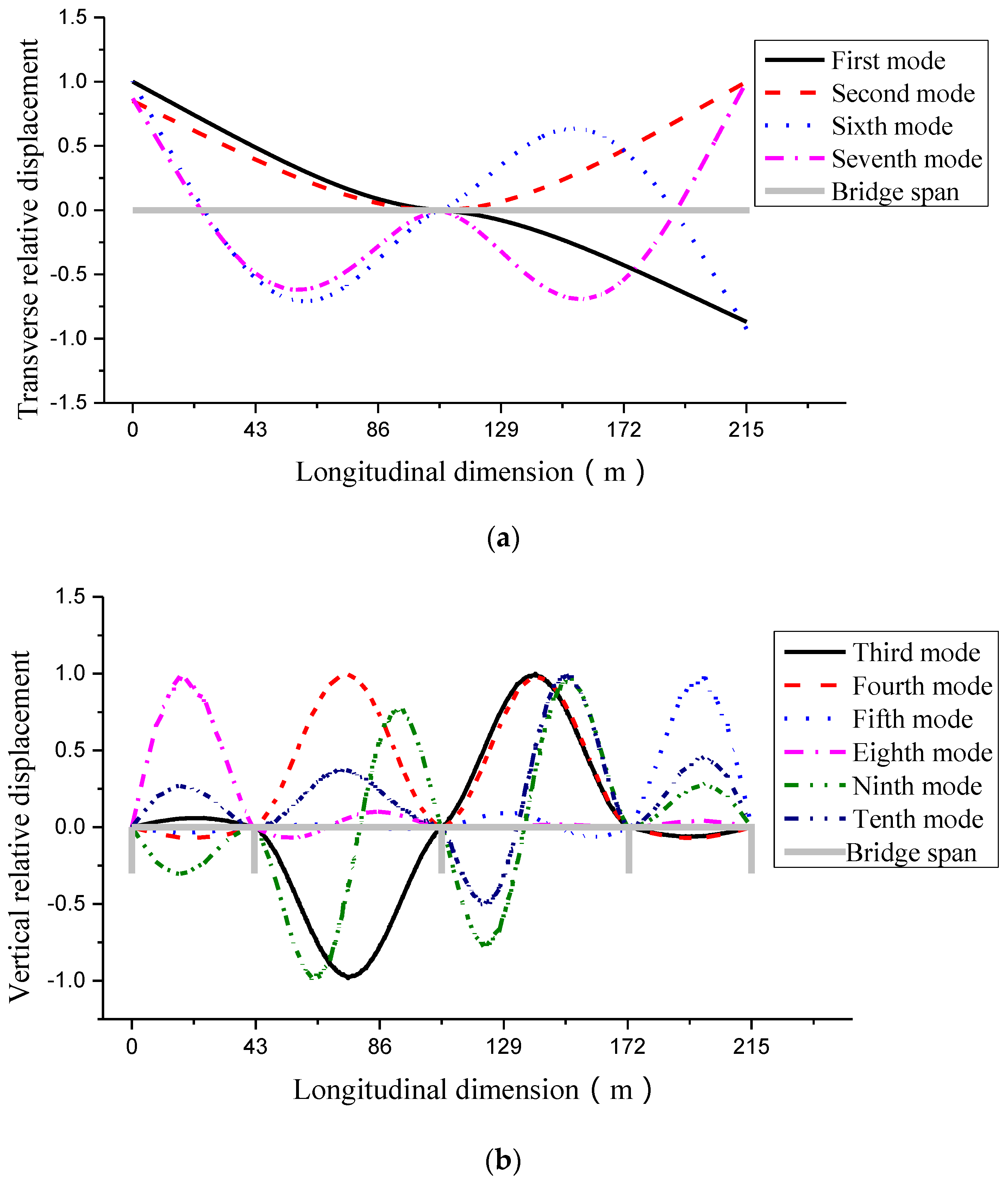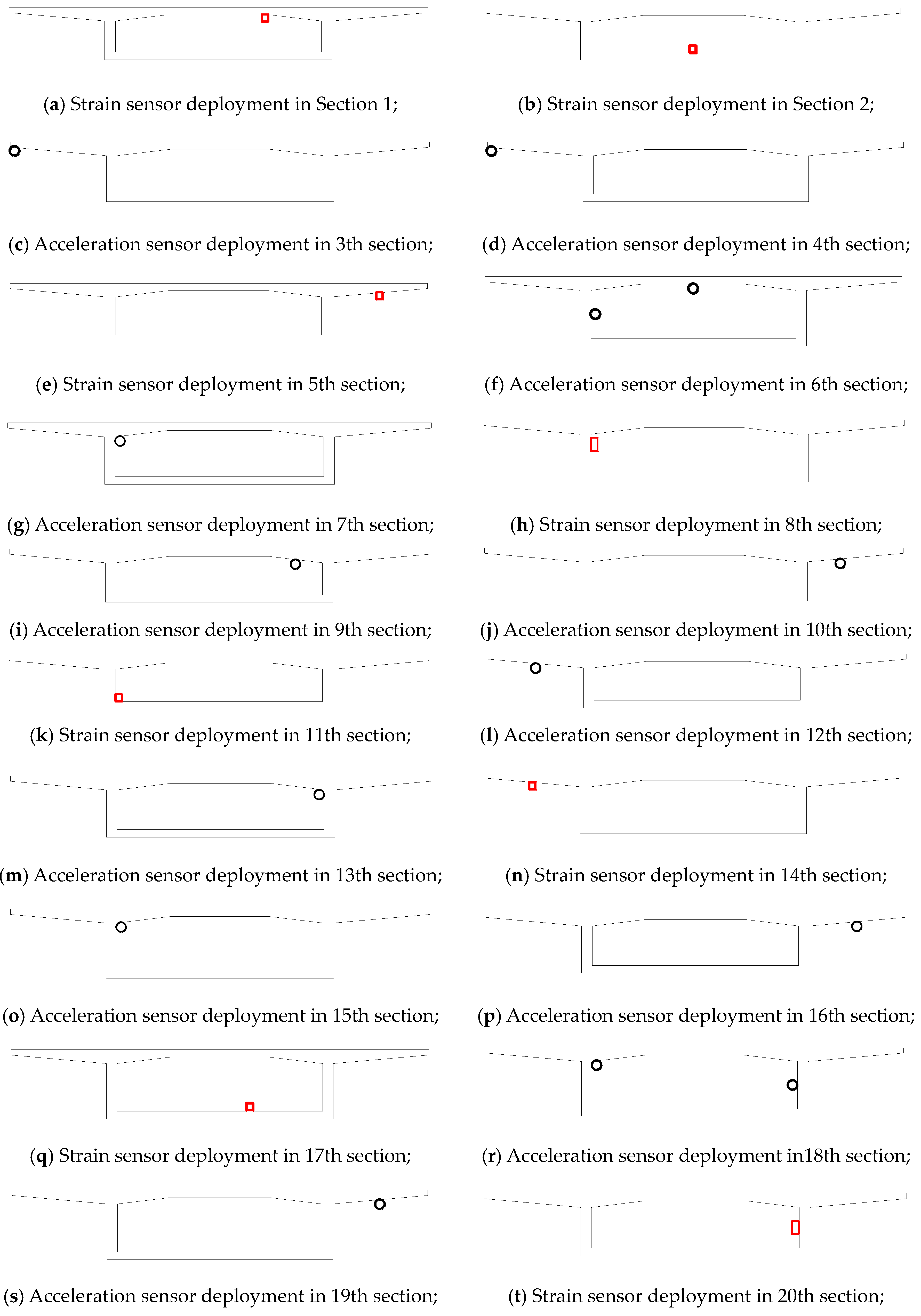Energy-Efficient Heterogeneous Wireless Sensor Deployment with Multiple Objectives for Structural Health Monitoring
Abstract
:1. Introduction
2. Optimization Problem Formulation in HWSNs
2.1. Heterogeneous Sensor Placement Quality
2.1.1. Modal Clarity Index
2.1.2. Modal Relative Error
2.1.3. Placement Quality Index
2.2. Network Model
3. Objective Function and Solution
3.1. Multi-Objective Optimization Function
3.2. Particle Swarm Optimization Algorithm
4. Network Topology Optimization
4.1. Two-Phase Energy Consumption Formulation
4.2. Optimal Clustering
5. Performance Evaluation
5.1. Simulation Setup
5.2. Sensor Layout Optimization Results
5.3. Clustering Optimization Results
6. Conclusions
Acknowledgments
Author Contributions
Conflicts of Interest
References
- Farrar, C.R.; Worden, K. An introduction to structural health monitoring. Phil. Trans. R. Soc. A 2007, 365, 303–315. [Google Scholar] [CrossRef]
- Feltrin, G.; Jalsan, K.E.; Flouri, K. Vibration monitoring of a footbridge with a wireless sensor network. J. Vib. Control 2013, 19, 2285–2300. [Google Scholar] [CrossRef]
- Casciati, S.; Faravelli, L.; Chen, Z. Energy harvesting and power management of wireless sensors for structural control applications in civil engineering. Smart Struct. Syst. 2012, 10, 299–312. [Google Scholar] [CrossRef]
- Spencer, F.B.; Ruiz-Sandoval, M.; Kurata, N. Smart sensing technology: Opportunities and challenges. Struct. Control Health Monit. 2004, 11, 349–368. [Google Scholar] [CrossRef]
- Jian, L.; Mechitov, A.K.; Kim, R.E.; Spencer, F.B. Efficient time synchronization for structural health monitoring using wireless smart sensor networks. Struct. Control Health Monit. 2016, 23, 470–486. [Google Scholar]
- Chin, J.C.; Rautenberg, J.M.; Ma, Y.T.; Pujol, S.; Yau, K.Y. An Experimental Low-Cost, Low-Data-Rate Rapid Structural Assessment Network. IEEE Sens. 2009, 9, 11. [Google Scholar]
- Fok, C.L.; Roman, G.C.; Lu, C.Y. Servilla: A flexible service provisioning middleware for heterogeneous sensor networks. Sci. Comput. Program. 2012, 77, 663–684. [Google Scholar] [CrossRef]
- Kim, S.; Pakzad, S.; Culler, D.; Demmel, J.; Fenves, G.; Glaser, S.; Turon, M. Health monitoring of civil infrastructures using wireless sensor networks. In Proceedings of the Sixth International Symposium on Information Processing in Sensor Networks, Cambridge, MA, USA, 25–27 April 2007; pp. 254–263.
- Jo, H.; Sim, S.H.; Mechitov, K.A.; Kim, R.; Li, J.; Moinzadeh, P.; Spencer, J.B.; Park, J.W.; Cho, S.; Jung, H.J.; et al. Hybrid wireless smart sensor network for full-scale structural health monitoring of a cable-stayed bridge. SPIE Proc. 2011, 7981. [Google Scholar] [CrossRef]
- Shinae, J.; Jo, H.; Cho, S.; Mechitov, K.; Rice, A.R.; Sim, S.-H.; Jung, H.-J.; Yun, C.-B.; Spencer, B.F.; Agha, G. Structural health monitoring of a cable-stayed bridge using smart sensor technology: Deployment and evaluation. Smart Struct. Syst. 2010, 6, 439–459. [Google Scholar]
- Weng, J.H.; Loh, C.H.; Lynch, J.P.; Lu, K.C.; Lin, P.Y.; Wang, Y. Output-only modal identification of a cable-stayed bridge using wireless monitoring systems. Eng. Struct. 2008, 30, 1820–1830. [Google Scholar] [CrossRef]
- Chae, M.J.; Yoo, H.S.; Kim, J.Y.; Cho, M.Y. Development of a wireless sensor network system for suspension bridge health monitoring. Autom. Constr. 2012, 21, 237–252. [Google Scholar] [CrossRef]
- Whelan, M.J.; Gangone, M.V.; Janoyan, K.D.; Jha, R. Real-time wireless vibration monitoring for operational modal analysis of an integral abutment highway bridge. Eng. Struct. 2009, 31, 2224–2235. [Google Scholar] [CrossRef]
- Whelan, M.J.; Gangone, M.V.; Janoyan, K.D.; Jha, R. Operational modal analysis of a multi-span skew bridge using real-time wireless sensor networks. J. Vib. Control 2011, 17, 1952–1963. [Google Scholar] [CrossRef]
- Kammer, D.C. Sensor placement for on-orbit modal identification and correlation of large space structures. In Proceedings of the IEEE American Control Conference, San Diego, CA, USA, 23–25 May 1990; pp. 2984–2990.
- Minwoo, C.; Shamim, N.P. Optimal Sensor Placement for Modal Identification of Bridge Systems Considering Number of Sensing Nodes. J. Bridge Eng. 2014, 19, 04014019. [Google Scholar]
- Heo, G.; Wang, M.L.; Satpathi, D. Optimal transducer placement for health monitoring of long span bridge. Soil Dyn. Earthq. Eng. 1997, 16, 495–502. [Google Scholar] [CrossRef]
- Bhuiyan, M.Z.A.; Wang, G.; Cao, J.N. Sensor deployment with multiple objectives for structural health monitoring. ACM Trans. Sens. Netw. 2014, 10, 68. [Google Scholar] [CrossRef]
- Bhuiyan, M.Z.A.; Cao, J.N. Deploying Wireless Sensor Networks with Fault-Tolerance for Structural Health Monitoring. IEEE Trans. Comput. 2015, 64, 382–395. [Google Scholar] [CrossRef]
- Onoufriou, T.; Soman, R.N.; Votsis, R.; Chrysostomou, C.; Kyriakides, M. Optimization of wireless sensor locations for SHM based on application demands and networking limitations. In Proceedings of the 6th International IABMAS Conference, Stresa, Italy, 8–12 July 2012.
- Zhou, G.D.; Yi, T.H.; Zhang, H.; Li, H.N. Energy-aware wireless sensor placement in structural health monitoring using hybrid discrete firefly algorithm. Struct. Control Health Monit. 2015, 22, 648–666. [Google Scholar] [CrossRef]
- Fu, T.S.; Ghosh, A.; Johnson, E.A.; Krishnamachari, B. Energy-efficient deployment strategies in structural health monitoring using wireless sensor networks. Struct. Control Health Monit. 2013, 20, 971–986. [Google Scholar] [CrossRef]
- Jalsan, K.E.; Soman, R.N.; Flouri, K.; Kyriakides, M.A.; Feltrin, G.; Onoufriou, T. Layout optimization of wireless sensor networks for structural health monitoring. Smart Struct. Syst. 2014, 14, 39–54. [Google Scholar] [CrossRef]
- Natarajan, S.; Howells, H.; Deka, D.; Walters, D. Optimization of sensor placement to capture riser VIV response. OMAE 2006, 5, 821–849. [Google Scholar]
- Levine-West, M.; Milman, M.; Kissil, A. Mode shape expansion techniques for prediction-experimental evaluation. AIAA J. 1996, 34, 821–829. [Google Scholar] [CrossRef]
- Ewins, D.J. Modal Testing, Theory, Practice and Application; Research Studies Press: Baldock, UK, 2000. [Google Scholar]
- Soman, R.N.; Onoufriou, T.O.; Votsis, R.; Chrysostomou, C.Z.; Kyriakides, M.A. Multi-type, multi-sensor placement optimization for structural health monitoring of long span bridges. Smart Struct. Syst. 2014, 14, 1–9. [Google Scholar] [CrossRef]
- Liu, C.Y.; He, X.Y. Wireless sensor integration for bridge model health monitoring. J. Vibroeng. 2013, 15, 1028–1040. [Google Scholar]
- Ye, F.; Zhong, G.; Cheng, J. PEAS: A Robust Energy Conserving Protocol for Long-lived Sensor Networks. In Proceedings of the International Conference on Distributed Computing Systems (ICDCS), Providence, RI, USA, 19–22 May 2003; pp. 28–37.
- Liu, C.Y.; Fang, K.; Teng, J. Optimum wireless sensor deployment scheme for structural health monitoring: A simulation study. Smart Mater. Struct. 2015, 24, 115034. [Google Scholar] [CrossRef]
- Yao, L.; Sethares, W.A.; Kammer, D.C. Sensor placement for on orbit modal identification via a genetic algorithm. AIAA J. 1993, 31, 1922–1928. [Google Scholar] [CrossRef]
- Kennedy, J. Small Worlds and Mega-Minds Effects of Neighborhood Topology on Particle Swarm Performance. In Proceedings of the IEEE Congress on Evolutionary Computation, Las Vegas, NV, USA, 6–9 July 1999; pp. 1931–1938.
- Yi, T.H.; Li, H.N.; Zhang, X.D. A modified monkey algorithm for optimal sensor placement in structural health monitoring. Smart Mater. Struct. 2012, 21, 105033. [Google Scholar] [CrossRef]
- Guo, Q.G.; Zhou, D.X.; Zhou, X.F. Calculation Method of Optimal Cluster Head in LEACH Routing Protocol. Netw. Commun. 2013, 2, 61–66. [Google Scholar] [CrossRef]









| Energy Consumption | Wireless Accelerometer Node | Wireless Strain Gauge Node |
|---|---|---|
| Data acquisition | Cca = aaK | Ccs = asK |
| Data processing | Cpa = badamK | Cps = bsdsmK |
| Data communication | Cta = (ga + dadam)K | Cts = (gs + dsdsm)K |
| Data receiving | Cra = eaK | Crs = esK |
| Parameter | Definition | Value |
|---|---|---|
| αa | energy consumption related to data collecting about accelerometer | 60 × 10−9 J/bit |
| βa | energy consumption related to data processing about accelerometer | 45 × 10−9 J/bit |
| γa | energy consumption related to the transmission distance about accelerometer | 45 × 10−9 J/bit |
| δa | energy consumption related to the transmission distance about accelerometer | 10 × 10−12 J/bit.m2 |
| εa | energy consumption related to data receiving about accelerometer | 135 × 10−9 J/bit |
| da | average distance between all nodes in a network layer to the base station or cluster head node in upper network layer | / |
| αs | energy consumption related to data collecting about strain sensor | 45 × 10−9 J/bit |
| βs | energy consumption related to data processing about strain sensor | 1.35 × 10−9 J/bit |
| γs | energy consumption related to data transmitting about strain sensor | 45 × 10−9 J/bit |
| δs | energy consumption related to the transmission distance about strain sensor | 10 × 10−12 J/bit.m2 |
| εs | energy consumption related to data receiving about strain sensor | 135 × 10−9 J/bit |
| ds | average distance between all nodes in a network layer to the base station or cluster head node in upper network layer | / |
| K | amount of data per second transmitting | 200 |
| Mode | Frequency (Hz) | Modal Shape |
|---|---|---|
| 1 | 0.669 | lateral |
| 2 | 0.746 | lateral |
| 3 | 3.291 | vertical |
| 4 | 3.541 | vertical |
| 5 | 4.051 | vertical |
| 6 | 4.367 | lateral |
| 7 | 5.118 | lateral |
| 8 | 5.370 | vertical |
| 9 | 7.935 | vertical |
| 10 | 8.450 | vertical |
| Number | 1 | 2 | 3 | 4 | 5 | 6 | 7 | 8 | 9 | 10 | Mean |
|---|---|---|---|---|---|---|---|---|---|---|---|
| Function Value | 154 | 188 | 173 | 138 | 157 | 185 | 122 | 99 | 162 | 63 | 144.1 |
| N1 (Accelerometer) | 14 | 14 | 15 | 14 | 15 | 13 | 15 | 13 | 13 | 14 | 14 |
| N2 (Strain Gauge) | 10 | 10 | 9 | 10 | 9 | 11 | 9 | 11 | 11 | 10 | 10 |
| R(m) (Coverage Range) | 103 | 97 | 89 | 98 | 99 | 100 | 91 | 101 | 100 | 102 | 96.7 |
| Parameter | Value |
|---|---|
| HSWN Space V | (0, 0, 0)~(215, −3.12, 13.75) |
| Accelerometer | 14 |
| Strain Sensor | 10 |
| Base Station Location | (107.5, 0, 6.875) |
| γ | 45 × 10−9 J/bit |
| ε | 135 × 10−9 J/bit |
| δfs | 10 × 10−12 J/bit/m2 |
| δmp | 0.0013 × 10−12 J/bit/m2 |
| d | 100 m |
| Network Topology | Energy Consumption (J) | Coverage Radius of Network (m) | ||
|---|---|---|---|---|
| First Layer | Second Layer | Entire Network | ||
| Flat | 0.0280 | — | — | 105.4 |
| Cluster-tree | 0.0210 | 32.7 | 102.5 | 135.2 |
| Difference (%) | 33.3 | — | — | 28.3 |
© 2016 by the authors; licensee MDPI, Basel, Switzerland. This article is an open access article distributed under the terms and conditions of the Creative Commons Attribution (CC-BY) license (http://creativecommons.org/licenses/by/4.0/).
Share and Cite
Liu, C.; Jiang, Z.; Wang, F.; Chen, H. Energy-Efficient Heterogeneous Wireless Sensor Deployment with Multiple Objectives for Structural Health Monitoring. Sensors 2016, 16, 1865. https://doi.org/10.3390/s16111865
Liu C, Jiang Z, Wang F, Chen H. Energy-Efficient Heterogeneous Wireless Sensor Deployment with Multiple Objectives for Structural Health Monitoring. Sensors. 2016; 16(11):1865. https://doi.org/10.3390/s16111865
Chicago/Turabian StyleLiu, Chengyin, Zhaoshuo Jiang, Fei Wang, and Hui Chen. 2016. "Energy-Efficient Heterogeneous Wireless Sensor Deployment with Multiple Objectives for Structural Health Monitoring" Sensors 16, no. 11: 1865. https://doi.org/10.3390/s16111865





